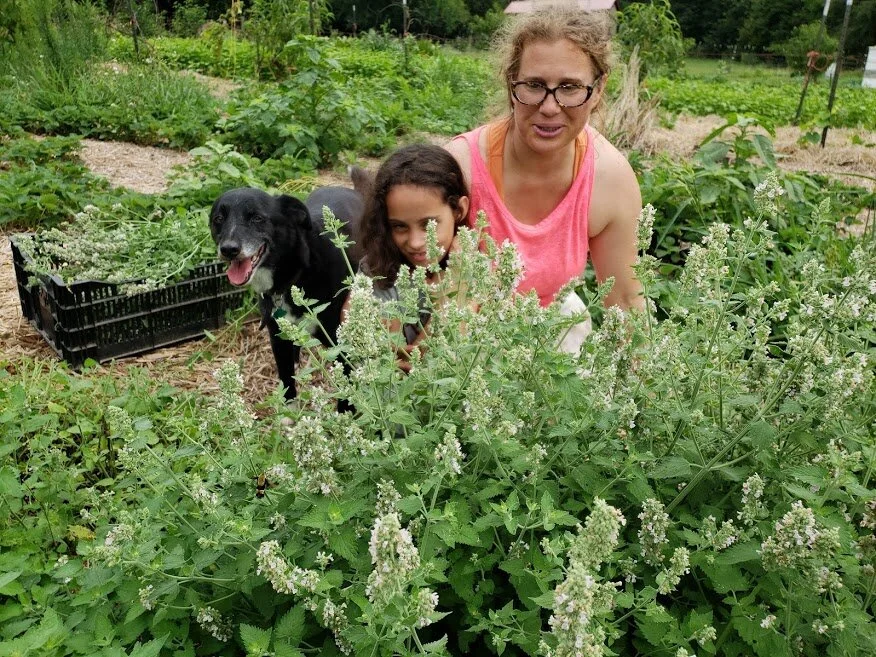
Teresa’s Home-Grown & Hand-Made Herb Teas — Start to Finish!
When I started making herb teas my very first year of farming (over 20 years ago now!), it was just a way to use up the fresh herbs that didn’t sell at the farmers market. In our family's "waste not; want not" tradition, I'd bring them home, un-bunch them, spread them out on the trays of my food dryer, dry them completely, and then experiment making different tea blends.
Today, my herbal teas are something that people know me by, and I couldn’t stop making them even if I wanted to! Which is a good thing because herb teas are delicious, calming, and healthful--utilizing many herbs that have been known for their medicinal qualities for thousands of years.
Scroll down for the step-by-step process from from herb plant to tea bag.
Growing annual and perennial herbs in the field
We grow just about every kind of herb that can be grown in central Illinois. The annual herbs are planted every spring and the perennial herbs are replanted from time to time when a planting dies out. I keep all my herbs a healthy by pruning them in the spring, keeping them weeded, mulching the beds with straw or hay, and fertilizing occasionally with compost.
Volunteers Suzanne and Wayra harvest catnip blossoms and leaves, with moral support provided by farmdog Bella!
That’s my 2020 intern Alyssa harvesting the chamomile.
2. Harvesting the fresh herbs and preparing them to dry
We use different parts of the plant for tea including the leaves, stems, flowers, and even fruit (in the case of aronia berries). If we are harvesting the flowers or fruit, we wait until they are at their peak before we harvest. When harvesting for leaves, which is mostly what we do, we wait until the plant is large enough to get a good amount of leaves, and then we keep harvesting throughout the season to keep the plant growing and healthy.
After harvesting, we immediately get the leaves ready for drying. This entails plucking the leaves off the stem one by one or in pairs, or for smaller leaves, stripping the leaves from the stem in one motion from top to bottom. This process can take hours and yield just a couple large bowls of leaves.
Buckets of freshly-plucked chamomile flowers
Big bucket of just-harvested aronia berries
Freshly-picked leaves from different kinds of mint
3. Drying and storing the herbs
Once the fresh leaves or flowers are removed from the stems, they are ready to dry. We spread them on the dryer trays and put 4 trays at a time into each food dryer. Some herbs dry in 6-8 hours, but others take much longer. When they are crispy-dry, they are stored in large tins so they remain fresh until use.
Trays of chamomile ready to be dried
Dried Chamomile
Dried lemongrass
Dried Lemon Verbena
4. Preparing and mixing the dry herbs
We tend to make tea on rainy or very hot days when it is difficult to work outside. After I see what dry herbs I have available, I decide which type of tea to make and assemble the tins of herbs that I need. For a few of our teas, we buy in certain herbs that do not grow here, such as cloves, cinnamon, and cardamom.
Many of the herbs I just crush in my hands, but some of the more tough leaves or stems need to be processed using a hand herb grinder or a coffee grinder. I measure the amount of each herbs into a large bowl and gently blend them together.
Bowl of Aronia Tea Ingredients — dried aronia berries, rose hips, orange peel, and hibiscus.
Bowl of a blend of different varieties of dried mint leaves
5. Filling and packaging the teabags
Finally, I spoon the tea blends into individual teabags that are open at the top. After a tray is full of filled teabags, we iron the tops shut, one by one, and package them in labeled plastic baggies. This year we are also going to start experimenting with bottling the tea blends in jars to reduce our use of plastic.























